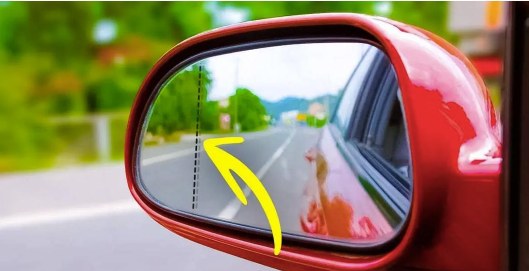When examining your car’s side mirrors, you may notice a vertical black stripe or a series of black dots along the edge. These features are not merely decorative; they serve specific functions designed to improve driver safety and visibility.
Aspherical Mirrors and the Vertical Black Stripe
Many modern vehicles are equipped with aspherical side mirrors, which differ from traditional flat mirrors. An aspherical mirror has a convex outer section that curves slightly outward, expanding the driver’s field of view. This design reduces blind spots, allowing for better awareness of surrounding traffic.
The vertical black stripe on these mirrors serves as a boundary between the flat inner portion and the convex outer section. This demarcation helps drivers distinguish between the two areas, aiding in depth perception and distance judgment. By understanding this distinction, drivers can more accurately interpret the information reflected in the mirror, enhancing overall driving safety.
The Role of Black Dots on Car Windows
In addition to side mirrors, you may observe black dots, known as ‘frits,’ around the edges of your car’s windows, particularly the windshield. These dots are part of the frit band—a ceramic paint baked into the glass during manufacturing. Frits serve several important purposes:
- Adhesion Support: The frit band provides a rough surface for adhesives, ensuring a secure bond between the glass and the vehicle frame. This is crucial for the structural integrity of the car, especially in the event of a collision.
- UV Protection: The black dots help block ultraviolet rays from the sun, protecting the adhesive bond from degradation over time. This prolongs the lifespan of the windshield’s attachment to the vehicle.
- Thermal Regulation: The gradient pattern of the dots helps distribute temperature evenly across the glass, reducing the risk of stress fractures caused by thermal expansion and contraction.
- Aesthetic Transition: The dots create a visually pleasing gradient that softens the transition between the opaque frame and the transparent glass, enhancing the vehicle’s overall appearance.
Importance of Understanding These Features
Recognizing the purpose of the black stripes on side mirrors and the black dots on windows can enhance your appreciation for automotive design focused on safety and functionality. These features are meticulously engineered to provide drivers with better visibility, protect critical components from environmental factors, and maintain the structural integrity of the vehicle.
Conclusion
The black dots and stripes on your car’s mirrors and windows are integral components designed with your safety in mind. Aspherical mirrors with vertical black stripes offer an expanded field of view, reducing blind spots and aiding in safer lane changes and turns. Similarly, the black dots on windows serve multiple functions, including supporting adhesion, providing UV protection, regulating temperature, and enhancing aesthetics. Understanding these features allows drivers to utilize them effectively, contributing to a safer driving experience.

